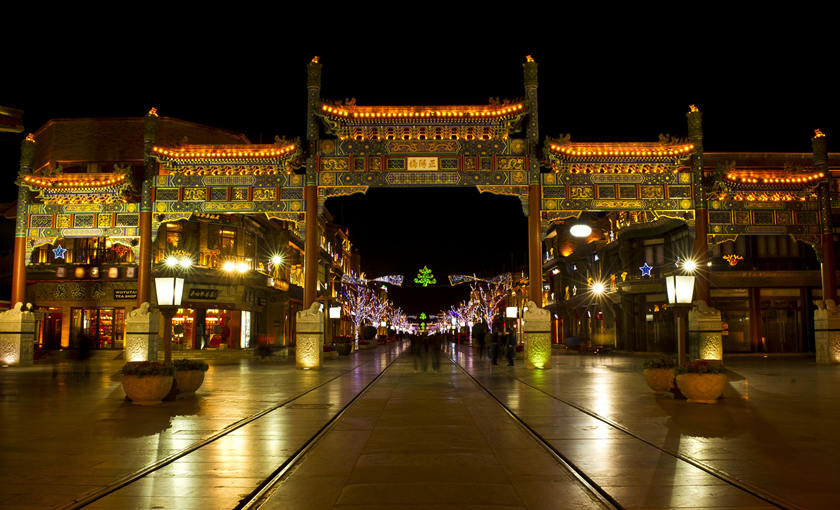Chinese Name: 前门大街 Pronunciation: qián mén dà jiē
Address: Dongcheng District, Beijing.
Length: About 1660 meters
Building Time: 1550
Best Visiting Season: All seasons
Admission Ticket Fare: Free
Opening Hours: All day
Suggested Visiting Hours: 1-2 Hours
Building Function: Before the construction of the outer city in 1550, it was the road dedicated to emperors to go out of the city to the Temple of Heaven and Shanchuantan(altar of the god of agriculture). After the construction of the outer city, it was the main north and south streets of the outer city.

Qianmen Street is a very famous commercial street in Beijing. It is located on the central Beijing axis, starting from Qianmen Moon Bay in the north, ending in Tianqiao Street in the south, and connected to Tianqiao South Street.
The main street is 845 meters long and 20 meters wide. It was called Zhengyang Gate Street from the Ming Dynasty and the Qing Dynasty to Republic of China, but commonly know as Qianmen Street among common people. It was officially named Qianmen Street in 1965.
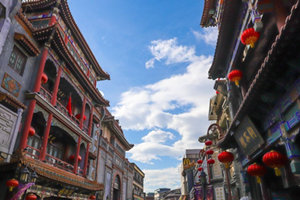
Qianmen Street in the Ming Dynasty was the boundary line between Zhengdong Lane and Zhengxi Lane. The two lanes were divided by the center line of the street, with Zhengdong Lane on the east and Zhengxi Lane on the west. Because Zhengyang Gate is the main gate of the capital, the Qianmen Street is wider than other city gate streets.
In terms of urban organization, the Beijing City in Ming Dynasty broke through the customization of the "royal court in the front and market in back" followed in the Yuan Dynasty, which made the area around Zhengyang Gate and Langfang Hutongs in the south a large commercial area.
In the mid Ming Dynasty, due to the development of commerce, markets and streets such as Xianyukou, Zhushikou, Meishikou, and grain shops appeared on both sides of Qianmen Street. Qianmen Street became a commercial street then. Beijing's most famous "Dashilan'er"(another famous commercial street) is also among them.
After 1566, officials from various provinces and cities in Beijing established various halls on both sides of Qianmen Street in order to provide accommodation for candidates entering Beijing for examinations. People often go to Qianmen Street to buy daily necessities or have a drink, which also promotes Qianmen Street to become a bustling commercial street.
In the early Qing Dynasty, the lantern market in Dongcheng District was moved to the Qianmen area. In order to maintain the dignity of the imperial power, theaters, tea houses, and brothels were only allowed to be opened in outer city which made Qianmen Street become more prosperous than before.
Many new markets appeared one by one on both sides of the main street in the Qing Dynasty, such as fresh fish market, meat market, fruit market, cloth market, pig market, jewelry market, melon seed market and so on. Many artisan workshops, warehouses, hotels, halls and theaters such as Qingle, Sanqing and Huale appeared in the nearby hutongs.
The sheltered houses on the main street were gradually transformed into formal brick-timbered houses, forming three streets with inner street behind the east and west sides. The east side street is the meat market street, cloth alley, and the fruit market, and the west side street is the jewelry market and food market.
Most of the shops on the main street of outside Qianmen Street were established later than those on inner street. There are Quanjude Roast Duck Restaurant, Yong'antang Pharmacy, Zhengyanglou Restaurant, Jiulongzhai Fresh Fruit Shop and others on the east side of the street. There are Yongzenghe Private Bank (old style bank in ancient China), Ruifuxiang Silk Shop, Tongrentang Pharmacy, Yitiaolong Mutton Shop and others on west side.
At the end of the Qing Dynasty, there had been a night market at Qianmen Street. After 1901, the East Station and West Station of Qianmen Railway Station were established on the east and west sides of Embrasured Watchtower in Qianmen, and then Qianmen Street became a transportation hub connecting Beijing with other provinces.
In the early 1950s, there were more than 800 basic private businesses in Qianmen area. The building area on both sides of Qianmen Street covers about 66,000 square meters, which can accommodate approximately 180 merchants.
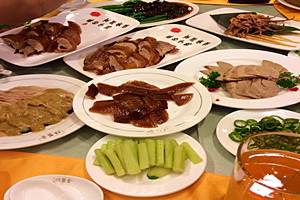
Quanjude Roast Duck was founded in 1864 by founder Yang Quanren in Meat Market Street, outside the Qianmen Street. It was awarded the "China Time-honored Brand" and “Beijing Time-honored Brand” by the Ministry of Commerce of China, and was recognized as a "Famous Trademark" by the State Administration for Industry and Commerce. It is the most famous and authentic roast duck restaurant in Beijing.
After continuous innovation and development, Quanjude’s dishes make Quanjude Roast Duck Restaurant always unique. The dishes in Quanjude’s menu are combination of "Full Duck Feast" (dishes made by duck liver, duck heart, duck gizzard, etc.) and more than 400 special dishes. It is loved by heads of state, government officials, people from all walks of life and domestic and foreign tourists, and known as "China's No. 1 Food". The Quanjude "Full Duck Feast" has been selected as one dish of the state banquet many times. The initial Quanjude is in Qianmen, Beijing. There are chain stores in Beijing and almost all other big cities in China.
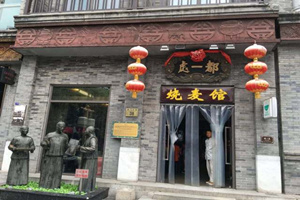
Located at No. 36 of the prosperous Qianmen Street, Duyichu Steamed Dumpling Restaurant was opened in 1738 and has a history of more than 280 years. It is one of Beijing’s famous century-old shops. It awarded "China Time-honored Brand" and “Beijing Time-honored Brand” by the Ministry of Commerce of China. The signature gourmet of this restaurant is steamed dumpling (“shao mai” in Chinese), which with thin skin and full stuff.
In 2000, Duyichu won the title of "Chinese Famous Snack" and the "Golden Tripod" award from the Ministry of Commerce. In the early days, it was famous for its side dishes such as boiled peanuts, rose jujubes, malian meat, dried meat, etc.
Nowadays, it mainly sells a variety of steamed dumplings, malian meat and Shandong style stir-fry. "Duyichu" has been famous since Emperor Qianlong rewarded them a plaque. The Beijing snack-Shao Mai (steamed dumpling) is not only famous in Beijing but also in the whole China.
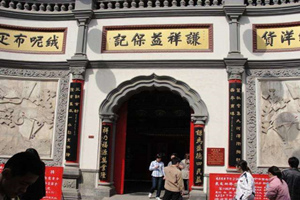
Qianxiangyi Silk Shop is located in Dazhalan Shopping Center, Qianmen Street, Xicheng District, Beijing. It is a quaint, solemn and beautiful long-established silk shop. It is also the first century-old brand of the eight famous silk brands. It has been awarded "China Time-honored Brand" and “Beijing Time-honored Brand” by the Ministry of Commerce of China. Founded in Qing Dynasty, it is currently one of the large-scale silk specialty shops with a full range of operations.
Qianxiangyi Silk Shop mainly engaged in silk fabrics, silk clothing, and silk handicrafts. It is an important window for China to spread silk culture and show the essence of China's silk. Qianxiangyi Silk Shop is located in a prominent position on the north side of Qianmen, directly leading to Qianmen Street. Hence, visitors to Qianmen will generally not miss this time-honored silk shop.
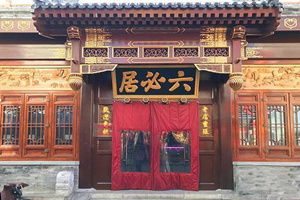
Beijing Liubiju is the oldest and most reputable company in Beijing Sauce Garden. It has been awarded "China Time-honored Brand" and “Beijing Time-honored Brand” by the Ministry of Commerce of China. The Liubiju pickle is a traditional famous dish in Beijing. The characteristics are fine selection of materials, strict production, superb processing skills, bright color, rich sauce, and moderate salt and sugar.
Liubiju Sauce Garden was founded in 1530 and has a history of more than 480 years. Now it is not only a must-have dish for many families in Beijing, but also one of the must-have dishes for state banquets. It has high historical and cultural value, nutritional and health care value, and brand value. The main products are Sweet Sauce Babao Melon, Sweet Sauce Black Vegetable, Sweet Sauce Nectar, Sweet Sauce Ginger Bud, etc. Many traditional pickles are now canned and sold abroad.
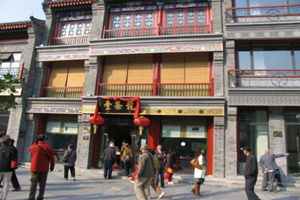
Yitiaolong Mutton Restaurant, also known as Yitiaolong Restaurant, is located at No. 27, Qianmen Street, Xicheng District, Beijing. Its former name is Nanhengshun Mutton Restaurant. It was founded in 1785 by a man whose surname is Han from Yucheng, Shandong. Now the restaurant is the oldest and famous Hui people's mutton restaurant in Beijing. Yitiaolong Restaurant was awarded the "Chinese Time-honored Brand" by the Ministry of Commerce of China.
Yitiaolong Mutton Restaurant's lamb is unique in its selection of ingredients. The staff need to go to the goat market in Madian to buy Xikou sheep (sheep from western China) and Beikou sheep (sheep from eastern China). Halal cuisine have their representative dishes such as fried shrimps, braised oxtail, fried lamb tail, crispy chicken and so on. Regardless of high, medium and low-end dishes, they are all prepared with meticulous workmanship and always with the tradition of time-honored brands.
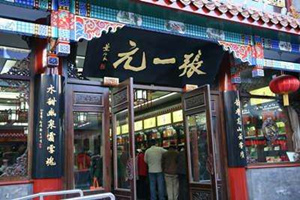
Zhangyiyuan Tea House's tea is of high quality, mellow in color and taste. Thanks to the good management of the entrepreneur Zhang Wenqing, the business of the tea house is good and the development is fast. In 1925, Zhang Wenqing personally went to Fujian to set up a tea farm. He built dozens of houses on the hillside in the outskirts of Fuzhou and hired local workers to buy freshly picked tea according to the season. Zhang Wenqing selected the best jasmine to make tea which was adapted to the taste of the northerners. He formed a characteristic small leaf flower tea. It is recognized for its clear soup, strong taste and endless aftertaste.
Zhang Wenqing's tea factory own their unique tea with much lower price than most wholesalers in Beijing. Therefore, Zhangyiyuan Tea House sells cheaper tea with same level than other brands. Zhangyiyuan Tea House also often sends their staff to other tea houses to compare the price, taste and customer’s comments to make the quality of their own tea superior to their peers.

Changchuntang Pharmacy opened in 1795 and has a history of more than 200 years. After reopening in 1996, it has a construction area of 2160 square meters and a business area of 960 square meters. Its unique antique building has become the new landscape of Qianmen Street. The internal shopping environment is comfortable. Changchuntang Pharmacy was awarded "Chinese Time-honored Brand" and "Beijing Tourism Designated Store" by government.
After Sun Sanming started operating Changchuntang in 1888, in order to compete with a Japanese medicine, Baodan, he devoted himself to research. After ten years of hard work, he finally successfully trial-produced a new medicine-Biwensan. Around 1933, Biwensan finally replaced the Japanese Baodan and monopolized the market and the sales volume reached 2.5 million boxes. It was the most prosper period of Changchuntang.
After the founding of People’s Republic of China, Changchuntang pharmacy moved from Fish Market to the east of outside the Qianmen Street. With the prosperity of Qianmen Street, Changchuntang’s business volume continued to expand, and they have more than 6,000 varieties of ginseng tonics and Chinese patent medicines. A western medicine counter was opened inside the pharmacy later.
Take bus 2, 5, 8, 9, 20, 22, 44, 48, 59, 66, 67, 82, 93, 120, 332, 599, 622, Night 2, Night 5, Night 17 or Night 18 and get off at Qianmen Station.
Take bus 2, 48, 20, 59, 66, 93, 120 or 622 and get off at Dazhalan Station.
By Subway
Take Metro Line 2 and get off at Qianmen Station.
By Taxi
Chinese: 请带我去前门大街。English: Please take me to Qianmen Street.
If you go to Qianmen Street from the Beijing International Airport, it takes about 80 minutes (88 yuan).
If you go to Qianmen Street from the Beijing Daxing International Airport, it takes about 90 minutes (155 yuan).
If you go to Qianmen Street from the Beijing West Train Station, it takes about 25 minutes (30 yuan).
